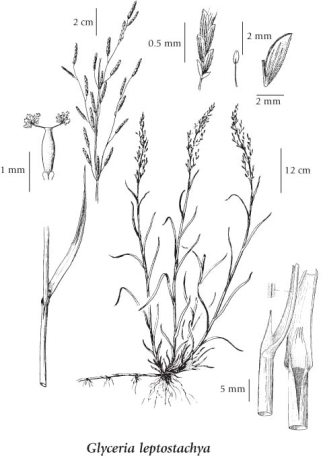Glyceria leptostachya Buckley
slender-spiked mannagrass (davy mannagrass)
Poaceae (Grass family)
Introduction to Vascular Plants
slender-spiked mannagrass (davy mannagrass)
Poaceae (Grass family)
Introduction to Vascular Plants
Introduction click to expand contents
This perennial, rhizomatous species of grass is found only along the western coast of North America in Alaska, British Columbia, Washington, Oregon and California (USDA 2011). In British Columbia, it is found in "Brackish tidal marshes, swamps, lakeshores, streamsides and wet meadows in the lowland zone" in coastal areas (Douglas et al. 2001). Lomer (2011) describes this species in BC and in the Fraser Valley: " A perennial grass from wet places in coastal BC. Known in the Fraser Valley from 6 sites in the Vancouver area, east to near Barnston Island, Surrey (UBC: Lomer 93-250). Elsewhere in BC it is widespread on the coast, but rarely encountered from the Queen Charlotte Islands south to Vancouver Island and the Gulf Islands. Generally a microscope is needed to separate it from Glyceria borealis (Nash) Batch., G. fluitans (L.) R. Br., or G. x occidentalis (Piper) J.C. Nelson, all of which occur in the Fraser Valley". [Originally reprinted from Botanical Electronic News # 435, with permission.]
|
Species Information click to expand contents
General:
Perennial grass from rhizomes; stems erect to decumbent, hollow, up to 60-100 (150) cm tall/long.
Leaves:
Sheaths somewhat flattened, finely rough, closed for most of their length but open for 1 cm or more; blades 3-7 mm wide, flat or somewhat in-rolled when dry, minutely rough on both surfaces; ligules pointed, the margins irregularly jagged, more or less finely hairy to rough, 6-11 mm long.
Flowers:
Inflorescence a loose panicle, up to 40 cm long, the few branches ascending to appressed; spikelets loosely 8- to 13- (15-) flowered, narrow, linear, nearly circular in cross-section, tapered to the tips, 12-18 mm long; glumes membranous, the lower ones 1.2-1.5 mm long, the upper ones nearly twice as long; lemmas prominently 7-nerved to the narrow, translucent upper margins, minutely rough between distinctly rough nerves, slightly over 3 mm long, the lowest ones 3-4 mm long; stamens 3; anthers slightly over 0.5 mm long.
Illustration click to expand contents

If more than one illustration is available for a species (e.g., separate illustrations were provided for two subspecies) then links to the separate images will be provided below. Note that individual subspecies or varietal illustrations are not always available.
Illustration Source: The Illustrated Flora of British Columbia
Ecology click to expand contents
Ecological Framework for Glyceria leptostachya
The table below shows the species-specific information calculated from
original data (BEC database) provided by the BC Ministry of Forests and Range.
(Updated August, 2013)
The table below shows the species-specific information calculated from
original data (BEC database) provided by the BC Ministry of Forests and Range.
(Updated August, 2013)
| Site Information |
Value / Class |
||
|
Avg |
Min |
Max |
|
| Elevation
(metres) |
785 | 750 | 820 |
| Slope
Gradient (%) |
13 | 0 | 27 |
|
Aspect (degrees) |
229 | 230 | 230 |
| Soil
Moisture Regime (SMR) [0 - very xeric; 4 - mesic; 8 - hydric] |
4 | 3 | 5 |
| Modal
Nutrient Regime
Class |
E | ||
| #
of field plots species was recorded in: |
2 | ||
| Modal
BEC Zone Class |
PP | ||
|
All BEC Zones (# of stations/zone) species was recorded in |
PP(2) | ||
|
Source:
Klinkenberg 2013
|
|||
Habitat and Range click to expand contents
Brackish tidal marshes, swamps, lakeshores, streamsides and wet meadows in the lowland zone; rare in coastal BC; N to SE AK and S to CA.
